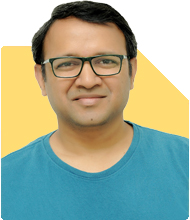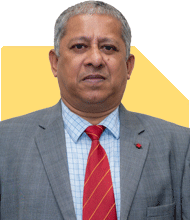40-Year-Old Investing 75,000 Monthly: How to Reach a 10 Crore Goal by 50?
Ramalingam Kalirajan |8897 Answers |Ask -Follow
Mutual Funds, Financial Planning Expert - Answered on Sep 16, 2024
He has an MBA in finance from the University of Madras and is a certified financial planner.
He is the director and chief financial planner at Holistic Investment, a Chennai-based firm that offers financial planning and wealth management advice.... more

Hi, I'm 40 years old, currently investigating 75000 monthly in axis small cap g 5000, axis small gap g 5000, HDFC mid cap oppo 5000, canara emerging 5000, SBI blue chip 5000, HDFC advantage 5000, axis blue chip 5000, uti nifty momentum30 5000, Nippon small cap 5000, quant small cap 25000. I already have 30lacs investment in mutual fund. I aim to have 10cr at 50years. Wat shud be my strategy. Please guide
You also have an existing mutual fund portfolio worth Rs 30 lakhs. To reach Rs 10 crores in 10 years, we need to ensure your investments are optimized for growth, risk, and consistency. Let's break down how you can get there.
Strengths of Your Current Investment Plan
Diversification: You have invested in small-cap, mid-cap, and blue-chip funds. This gives your portfolio a healthy mix of high-risk, high-return investments (small-cap) and relatively stable ones (blue-chip).
High SIP Amount: Investing Rs 75,000 per month is a significant amount. Combined with your Rs 30 lakh corpus, it gives you a strong foundation.
Long-Term Focus: Your goal of 10 years aligns well with equity mutual funds, which are generally known to perform better over longer periods. Equity investments typically need at least 7-10 years to show substantial returns.
Now, let’s assess the areas where you can improve to enhance your chances of reaching Rs 10 crores.
Areas to Reconsider and Improve
1. Overexposure to Small-Cap Funds
While small-cap funds can offer very high returns, they come with increased risk. You are currently allocating a large portion of your monthly SIP into small-cap funds. This could lead to volatility in your portfolio, especially during market downturns.
Suggestion: Gradually shift some allocation from small-cap funds to more balanced or large-cap funds. This will help reduce volatility and stabilize your returns in the long term.
2. Mid-Cap and Blue-Chip Balance
Your mid-cap and blue-chip investments are a positive aspect of your portfolio. Mid-cap funds provide a good balance of growth potential and risk, while blue-chip funds are more stable, focusing on large, well-established companies.
Recommendation: Ensure you are not under-investing in these categories. The stability provided by blue-chip and mid-cap funds will help you in meeting your goal with reduced risk.
3. Investment in Actively Managed Funds
You have a mix of active funds, which is commendable. Actively managed funds, especially those run by experienced fund managers, can outperform index funds in the long term, especially in dynamic markets like India.
Why Avoid Index Funds: Index funds might look attractive due to low fees, but they are passive in nature. They merely follow the market and do not provide the expertise of a fund manager who can adjust the portfolio based on market trends. Actively managed funds offer flexibility and the potential to outperform the index in certain market conditions.
4. Avoiding Direct Funds
If you’re investing directly without the help of a Certified Financial Planner (CFP) or Mutual Fund Distributor (MFD), it could be costing you more than you realize. Regular plans offer the benefit of expert guidance, rebalancing advice, and personalized financial planning.
Benefits of Regular Funds: With regular funds, you get access to ongoing portfolio monitoring and professional advice. This can help you optimize your investments and reach your goals more efficiently. Direct funds might save on expense ratios, but the value lost in terms of financial advice can outweigh this.
5. Risk Management
Your investment strategy is aggressive, which is fine considering your goal and time horizon. However, make sure that you’re also considering the downside risks. The stock market is volatile, and while equities can provide high returns, they also come with the possibility of short-term losses.
Action Point: Include a well-thought-out risk management plan. You can consider investing a portion in debt funds or hybrid funds to create a cushion against market corrections.
Next Steps to Achieve Rs 10 Crores
Let’s break down some strategic steps you can implement right now to improve your chances of achieving your Rs 10 crore goal:
1. Increase SIP Amount Gradually
Although Rs 75,000 per month is already a significant investment, try to increase your SIP amount as your income grows. Even small increments can make a huge difference over time due to the power of compounding.
2. Rebalance Your Portfolio Annually
Ensure you are rebalancing your portfolio regularly to stay aligned with your risk tolerance and financial goals. Markets fluctuate, and certain funds will outperform others. Rebalancing will help lock in gains and reduce exposure to funds that might have become too risky.
3. Focus on Long-Term Performance
When choosing funds, focus on those with a long track record of consistent performance. Look for funds that have consistently outperformed their benchmarks over a 5-10 year period. Avoid getting lured by short-term top performers or trendy sectors.
4. Tax-Efficient Planning
Ensure that your investments are tax-efficient. Use tax-saving mutual funds (ELSS) to reduce your taxable income under Section 80C. Long-term capital gains (LTCG) from equity mutual funds are taxed at 10% above Rs 1 lakh per year. Plan your redemptions accordingly to minimize tax liability.
Importance of Financial Discipline
Your success in reaching Rs 10 crores will not only depend on the performance of your mutual funds but also on your financial discipline. Ensure that you stay consistent with your SIPs, avoid unnecessary withdrawals, and maintain an emergency fund to meet any sudden financial needs without disturbing your investments.
Emergency Fund
You must have an emergency fund that covers at least 6-12 months of your expenses. This will help you avoid withdrawing from your mutual fund portfolio in case of financial emergencies. Keep this fund in liquid assets such as liquid funds or short-term debt funds.
Additional Considerations for Wealth Building
Avoid Timing the Market: Stay invested for the long term. Don’t try to time the market or make impulsive decisions based on short-term fluctuations.
Review Fund Performance: Although equity mutual funds should be held for the long term, do keep an eye on their performance. If a fund consistently underperforms for more than 2-3 years, you may need to replace it with a better option.
Diversify Within Equity: While you already have diversification, ensure you aren’t overly reliant on any particular sector or theme. A broad-based equity portfolio will lower the risk of any one sector dragging down your overall returns.
Investment Through SIPs
Your strategy of investing through SIPs (Systematic Investment Plans) is excellent. SIPs allow you to take advantage of market volatility by averaging your purchase cost over time. They also help in maintaining investment discipline, as money is invested regularly regardless of market conditions.
Continue SIPs Uninterrupted: Even during market downturns, do not stop your SIPs. In fact, downturns can provide excellent buying opportunities, and you may accumulate more units at lower prices.
How a Certified Financial Planner Can Help
Consulting a Certified Financial Planner (CFP) will give you an edge. They can guide you in making the right decisions, provide portfolio rebalancing advice, and keep you on track with your financial goals. Their role is especially important when navigating complex financial landscapes and ensuring your investments are aligned with your life goals.
Why Regular Funds via CFPs are Better: CFPs can offer more than just fund recommendations. They provide strategic guidance, tax planning, and long-term financial planning. This personal touch and expertise are often missing in direct funds, which can lead to costly mistakes.
Final Insights
You are on a promising path toward achieving your goal of Rs 10 crores by age 50. However, it is important to make small but crucial adjustments to your current strategy to improve risk management and ensure long-term growth.
By slightly reducing exposure to small-cap funds, diversifying within mid-cap and large-cap funds, increasing SIP contributions gradually, and rebalancing your portfolio annually, you can significantly increase your chances of reaching your financial goal. Regular portfolio monitoring and the help of a Certified Financial Planner will further ensure that you stay on the right track.
Best Regards,
K. Ramalingam, MBA, CFP,
Chief Financial Planner,
www.holisticinvestment.in
Best Regards,
K. Ramalingam, MBA, CFP,
Chief Financial Planner,
www.holisticinvestment.in
You may like to see similar questions and answers below
Ramalingam Kalirajan |8897 Answers |Ask -Follow
Mutual Funds, Financial Planning Expert - Answered on Apr 04, 2024
Ramalingam Kalirajan |8897 Answers |Ask -Follow
Mutual Funds, Financial Planning Expert - Answered on May 17, 2024
Ramalingam Kalirajan |8897 Answers |Ask -Follow
Mutual Funds, Financial Planning Expert - Answered on May 09, 2024
Ramalingam Kalirajan |8897 Answers |Ask -Follow
Mutual Funds, Financial Planning Expert - Answered on Sep 27, 2024
Ramalingam Kalirajan |8897 Answers |Ask -Follow
Mutual Funds, Financial Planning Expert - Answered on Oct 16, 2024
Dr Nagarajan J S K |980 Answers |Ask -Follow
NEET, Medical, Pharmacy Careers - Answered on Jun 11, 2025
Patrick Dsouza | Answer |Ask -Follow
CAT, XAT, CMAT, CET Expert - Answered on Jun 11, 2025
Dr Nagarajan J S K |980 Answers |Ask -Follow
NEET, Medical, Pharmacy Careers - Answered on Jun 11, 2025
Dr Nagarajan J S K |980 Answers |Ask -Follow
NEET, Medical, Pharmacy Careers - Answered on Jun 11, 2025
Dr Nagarajan J S K |980 Answers |Ask -Follow
NEET, Medical, Pharmacy Careers - Answered on Jun 11, 2025
Dr Nagarajan J S K |980 Answers |Ask -Follow
NEET, Medical, Pharmacy Careers - Answered on Jun 11, 2025
Prof Suvasish Mukhopadhyay |1195 Answers |Ask -Follow
Career Counsellor - Answered on Jun 11, 2025
Prof Suvasish Mukhopadhyay |1195 Answers |Ask -Follow
Career Counsellor - Answered on Jun 11, 2025
Prof Suvasish Mukhopadhyay |1195 Answers |Ask -Follow
Career Counsellor - Answered on Jun 11, 2025
Prof Suvasish Mukhopadhyay |1195 Answers |Ask -Follow
Career Counsellor - Answered on Jun 11, 2025






















